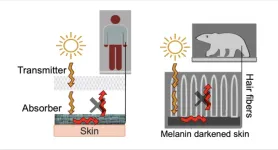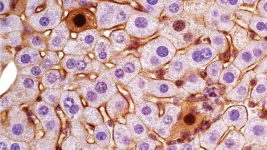(Press-News.org) AMHERST, Mass. – Three engineers at the University of Massachusetts Amherst have invented a fabric that concludes the 80-year quest to make a synthetic textile modeled on Polar bear fur. The results, published recently in the journal ACS Applied Materials and Interfaces, are already being developed into commercially available products.
Polar bears live in some of the harshest conditions on earth, shrugging off Arctic temperatures as low as -50 Fahrenheit. While the bears have many adaptations that allow them to thrive when the temperature plummets, since the 1940s scientists have focused on one in particular: their fur. How, the scientific community has asked, does a polar bear’s fur keep them warm?
Typically, we think that the way to stay warm is to insulate ourselves from the weather. But there’s another way: One of the major discoveries of the last few decades is that many polar animals actively use the sunlight to maintain their temperature, and polar bear fur is a well-known case in point.
Scientists have known for decades that part of the bears’ secret is their white fur. One might think that black fur would be better at absorbing heat, but it turns out that the polar bears’ fur is extremely effective at transmitting solar radiation toward the bears’ skin.
“But the fur is only half the equation,” says the paper’s senior author, Trisha L. Andrew, associate professor of chemistry and adjunct in chemical engineering at UMass Amherst. “The other half is the polar bears’ black skin.”
As Andrew explains it, polar bear fur is essentially a natural fiberoptic, conducting sunlight down to the bears’ skin, which absorbs the light, heating the bear. But the fur is also exceptionally good at preventing the now-warmed skin from radiating out all that hard-won warmth. When the sun shines, it’s like having a thick blanket that warms itself up, and then traps that warmth next to your skin.
What Andrew and her team have done is to engineer a bilayer fabric whose top layer is composed of threads that, like polar bear fur, conduct visible light down to the lower layer, which is made of nylon and coated with a dark material called PEDOT. PEDOT, like the polar bears’ skin, warms efficiently.
So efficiently, in fact, that a jacket made of such material is 30% lighter than the same jacket made of cotton yet will keep you comfortable at temperatures 10 degrees Celsius colder than the cotton jacket could handle, as long as the sun is shining or a room is well lit.
“Space heating consumes huge amounts of energy that is mostly fossil fuel-derived,” says Wesley Viola, the paper’s lead author, who completed his Ph.D. in chemical engineering at UMass and is now at Andrew’s startup, Soliyarn, LLC. “While our textile really shines as outerwear on sunny days, the light-heat trapping structure works efficiently enough to imagine using existing indoor lighting to directly heat the body. By focusing energy resources on the ‘personal climate’ around the body, this approach could be far more sustainable than the status quo.”
The research, which was supported by the National Science Foundation, is already being applied, and Soliyarn has begun production of the PEDOT-coated cloth.
Contacts: Trisha Andrew, tandrew@umass.edu
Daegan Miller, drmiller@umass.edu
END
New textile unravels warmth-trapping secrets of polar bear fur
Team of UMass Amherst engineers invents bilayered fabric, 30% lighter than cotton and far warmer
2023-04-10
ELSE PRESS RELEASES FROM THIS DATE:
Navigating the cosmos with Georgia State’s CHARA Array
2023-04-10
ATLANTA—Plans are underway to add a seventh movable telescope to Georgia State University’s Center for High Angular Resolution Astronomy— known as the CHARA Array—that would increase the resolution, or the ability to see small objects, by a factor of three.
Located at Mount Wilson Observatory in Southern California and operated by Georgia State, the new telescope will be connected using fiber optics to transport the starlight, a technique that will serve as a pathfinder ...
BU doc honored by the Association of University Radiologists
2023-04-10
(Boston)— Priscilla J. Slanetz, MD, MPH, professor of radiology at Boston University Chobanian & Avedisian School of Medicine, was awarded the 2023 Association of Program Directors in Radiology (APDR) Achievement Award at the Association of University Radiologists’ annual meeting. The honor is given for outstanding service to APDR or to someone who has made significant contributions to the advancement of education in radiology.
Slanetz is a practicing breast radiologist at Boston Medical Center specializing in all aspects of breast imaging including screening, diagnostic evaluation and image-guided intervention, providing breast care to Boston’s most vulnerable ...
BU researcher awarded $1.5 million NIH grant
2023-04-10
Boston—Esther Bullitt, PhD, associate professor of pharmacology, physiology & biophysics at Boston University Chobanian & Avedisian School of Medicine, was awarded $1.5 million from the National Institutes of Health that will go toward the purchase of a cryogenic electron microscope. Additional funds have been pledged by University President Robert A. Brown and Professor and Chair of Pharmacology, Physiology & Biophysics Venetia Zachariou, PhD.
The FEI ThermoFisher Glacios-2 cryo-EM is capable of determining structures at near-atomic resolution. Researchers will use this new instrumentation to study cellular function and dysfunction, and to guide ...
New UK data system will help predict and prevent opioid overdoses in Kentucky
2023-04-10
LEXINGTON, Ky. (April 10, 2023) — University of Kentucky researchers are creating an innovative statewide surveillance system to inform prevention and response efforts aimed at reducing the burden of opioid use disorder in Kentucky.
The Rapid Actionable Data for Opioid Response in Kentucky (RADOR-KY) will use data from federal, state, and local sources to guide evidence-based practices aimed at preventing opioid overdoses in the Commonwealth. Phase one of the project is supported by a three-year $3.1 million grant from the National Institute on Drug Abuse (NIDA).
Driven by the COVID-19 pandemic and illegally manufactured fentanyl, drug overdose ...
AACR announces recipients of the 2023 AACR June L. Biedler Prize for Cancer Journalism
2023-04-10
PHILADELPHIA – The American Association for Cancer Research (AACR) is pleased to announce the recipients of the 2023 AACR June L. Biedler Prize for Cancer Journalism in the following categories:
Auditory Journalism
“‘No Mercy’ Chapter 5: With Rural Hospital Gone, Cancer Care Means a Daylong Trek”
Sarah Jane Tribble (Photo), Taunya English (Photo), Kaiser Health News
Greg Munteanu (Photo), Saint Louis Public Radio
Magazine
“One Man’s Search for the DNA Data That Could Save His Life”
By ...
Identifying cancer genes’ multiple personalities
2023-04-10
Mutations in our genes can lead to severe problems, like colon or liver cancer. But cancer is very complex. Mutations in the same genes can lead to different subtypes of tumors in different people. Currently, scientists don’t have a good way to produce such tumor subtypes for study in the lab.
Now, Cold Spring Harbor Laboratory Assistant Professor Semir Beyaz has created a new method to model certain liver cancer tumor subtypes using the gene-editing tool CRISPR-Cas9.
Genes contain the information our bodies need to create proteins. Highly similar proteins produced from the same gene are called isoforms. Different isoforms generate ...
Recent advances in mushroom research
2023-04-10
So, mushroom-zombies recently took over a fictional world, but in real life, they’re really not so scary. These fungi range in shape from broad, plate-like portobellos and gangly enokis to a version resembling a giant, shaggy lion’s mane. And now scientists are finding ways to grow mushrooms on new materials, as well as incorporate them in more sustainable products. Below are some recent papers published in ACS journals that report insights into additional applications for mushrooms. Reporters can request free access to these ...
Giant, swimming mouths: Oral dimensions of extant sharks do not accurately predict body size in Dunkleosteus terrelli (Placodermi: Arthrodira)
2023-04-10
A new study by Case Western Reserve University PhD student Russell Engelman published in PeerJ Life & Environment attempts to address a persistent problem in paleontology – what were the size of Dunkleosteus and other late Devonian arthrodire placoderms. Arthrodire placoderms are extinct fishes with had armor covering their head and part of their torso, but like sharks the rest of their skeleton was made of cartilage, meaning most of their body did not preserve when they became fossilized.
Previous size estimates for Dunkleosteus were ...
Scheduled childbirth may greatly reduce preeclampsia, a leading cause of maternal death
2023-04-10
Research Highlights:
Analysis found that more than half of preeclampsia cases that occur during weeks 37-42 of pregnancy (called at-term preeclampsia) may be prevented with timed birth, such as a scheduled induction or Cesarean delivery.
Planned labor inductions and Cesarean deliveries are already widely practiced for a range of reasons, however, they are seldom considered as an intervention to prevent at-term preeclampsia, which may be life-threatening.
Embargoed until 4 a.m. CT/5 a.m. ET Monday, April 10, 2023
DALLAS, April ...
Non-biological factors and social determinants of health important in women’s CVD risk assessment
2023-04-10
Statement Highlights:
A new American Heart Association scientific statement reviews research about racial and ethnic differences in cardiovascular risk factors among women in the U.S.
In addition to traditional risk factors, women of underrepresented races or ethnicities experience challenges in the diagnosis and treatment of cardiovascular conditions due to language barriers, discrimination, difficulties in acculturation or assimilation, lack of financial resources or health insurance, or lack of access to health care.
Women of racial and ethnic backgrounds other than white have been underrepresented ...
LAST 30 PRESS RELEASES:
Norbert Holtkamp appointed director of Fermi National Accelerator Laboratory
New agentic AI platform accelerates advanced optics design
Biologists discover neurons use physical signals — not electricity — to stabilize communication
Researchers discover that a hormone can access the brain by hitchhiking
University of Oklahoma researcher awarded funding to pursue AI-powered material design
Exploring how the visual system recovers following injury
Support for parents with infants at pediatric check-ups leads to better reading and math skills in elementary school
Kids’ behavioral health is a growing share of family health costs
Day & night: Cancer disrupts the brain’s natural rhythm
COVID-19 vaccination significantly reduces risk to pregnant women and baby
The role of vaccination in maternal and perinatal outcomes associated with COVID-19 in pregnancy
Mayo Clinic smartwatch system helps parents shorten and defuse children's severe tantrums early
Behavioral health spending spikes to 40% of all children’s health expenditures, nearly doubling in a decade
Digital cognitive behavioral treatment for generalized anxiety disorder
Expenditures for pediatric behavioral health care over time and estimated family financial burden
Air conditioning in nursing homes and mortality during extreme heat
The Alps to lose a record number of glaciers in the next decade
What makes a good proton conductor?
New science reporting guide published for journalists in Bulgaria
New international study reveals major survival gaps among children with cancer
New science reporting guide published for journalists in Turkey
Scientists develop a smarter mRNA therapy that knows which cells to target
Neuroanatomy-informed brain–machine hybrid intelligence for robust acoustic target detection
Eight SwRI hydrogen projects funded by ENERGYWERX
The Lundquist Institute and its start-up company Vitalex Biosciences Announces Strategic Advancement of Second-Generation fungal Vaccine VXV-01 through Phase 1 Trials under $40 Million Competitive Con
Fine particles in pollution are associated with early signs of autoimmune disease
Review article | Towards a Global Ground-Based Earth Observatory (GGBEO): Leveraging existing systems and networks
Penn and UMich create world’s smallest programmable, autonomous robots
Cleveland researchers launch first major study to address ‘hidden performance killer’ in athletes
To connect across politics, try saying what you oppose
[Press-News.org] New textile unravels warmth-trapping secrets of polar bear furTeam of UMass Amherst engineers invents bilayered fabric, 30% lighter than cotton and far warmer




